Last updated: November 18, 2019
Article
Early Detection News – Spring 2018
Beginning of 2018 Field Season
Invasive Species Early Detection (ISED) team surveys began in April this year. The field crew consists of lead biotech Sarah Inman, and interns Steven Cognac and Polly Gnepa. Surveys will be concentrated at Point Reyes National Seashore this year, with some additional work at Pinnacles National Park, and John Muir National Historic Site.
Noteworthy Early Detections
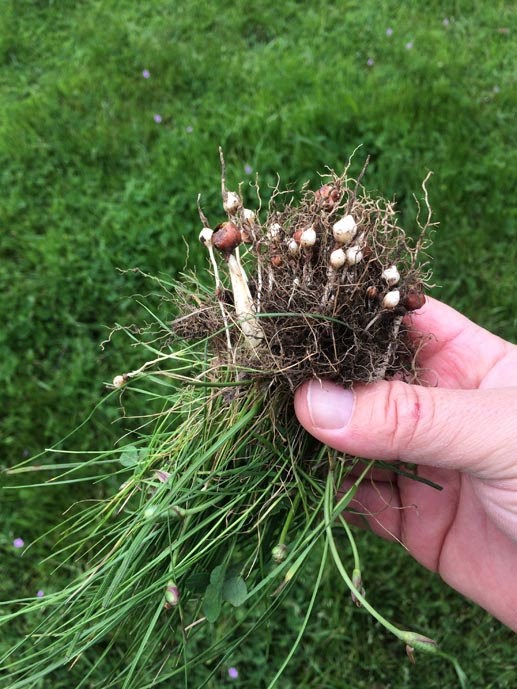
NPS / Eric Wrubel
Rosy sand crocus
(Romulea rosea var. australis)
During early-season surveys, ISED detected numerous patches of rosy sand crocus growing in trails and grasslands at Tomales Point, Laird’s Landing, and Bull Point. Extensive infestations have been documented in rangelands at Point Reyes in recent years. This short-statured plant only flowers for a brief period in early spring, and is largely undetectable for the rest of the year. It is likely that most of the populations mapped during this year’s surveys have been established for years, but were not previously detected due to survey timing.
Rosy sand crocus is a pink-flowered member of the Iris family, with tough grass-like leaves, and underground bulbs. It was introduced to California as an ornamental, and as a contaminant in clover seed for pastures. It is native to the Cape region of South Africa, and is widely naturalized in Australia, where it displaces desirable rangeland plants, and is considered a noxious agricultural weed. It has a high reproductive capacity, producing copious seeds and bulb offsets. Large numbers of seeds and bulbs may be dispersed by grazing or mowing. It can significantly reduce productivity in crops and pastures, and has no forage value. Undigested fiber balls can accumulate in the stomachs of grazing animals, causing digestive disorders and sometimes death.
Rosy sandcrocus is emerging as a troublesome pest plant of coastal rangelands in West Marin. Point Reyes Range Ecologist Dylan Voeller reports a dramatic increase over the past several years in grazed annual grasslands at Point Reyes, where it is now widely established. Elsewhere in San Francisco Bay Area Network (SFAN) parks, this species is uncommonly found growing in trails. Notable exceptions in the Golden Gate National Recreation Area include large populations in historically grazed grasslands at Rancho Corral de Tierra, and a small patch in the mowed historic Rifle Range at Fort Baker.
Resources:
Global Invasive Species Team Weed Alert!
Onion Grass (Romulea rosea) - Management in Pastures
Calflora taxon report
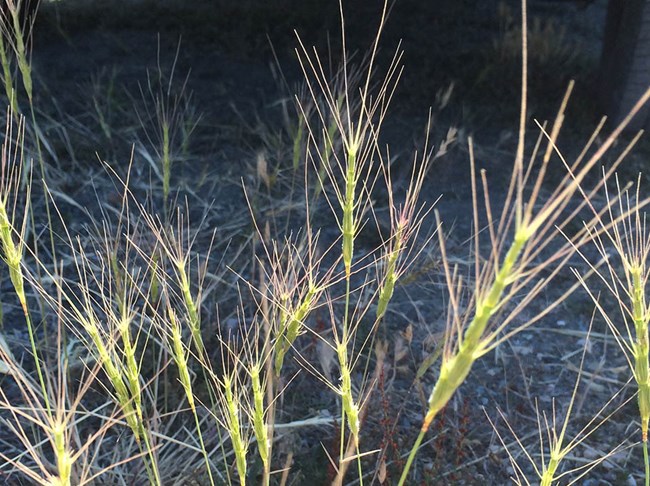
NPS / Eric Wrubel
Barbed goatgrass
(Aegilops truincialis)
In June, ISED removed a large population of barbed goatgrass at the Bear Valley parking lot in Point Reyes. This highly invasive Eurasian grass was first reported in Point Reyes at the same site in 2008, by Doreen Smith. It was treated for several years, and considered eradicated, but reappeared in 2015. Annual treatments since then have not eliminated the population. Maintenance mowing of the parking lot spreads the seeds and confounds detection efforts.
Barbed goatgrass outcompetes herbaceous species by forming dense mats of growth early in the season, and dying back to a thick mulch after fruiting. The grass is generally avoided by grazing animals due to its sharp awns. Barbed goatgrass is one of the few introduced annual grasses that is tolerant of serpentine soils, and poses a threat to serpentine endemic species. It is expanding its range in Northern and Central California. The California Invasive Plant Council (Cal-IPC) classifies its potential impact on California’s native ecosystems as HIGH, and it is listed as a B-rated noxious weed by the California Department of Food and Agriculture (CDFA).
Resources:
Aegilops truincialis profile - Cal-IPC
Aegilops truincialis profile - bugwood.org
Barb goatgrass-UCANR Publication 8315
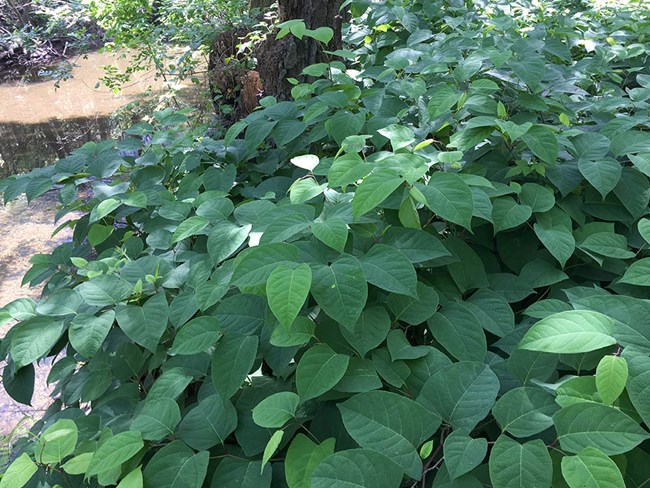
NPS / Eric Wrubel
Japanese knotweed
(Fallopia japonica)
In June, ISED joined forces with the Exotic Plant Management Team (EPMT) in ongoing surveillance, mapping, and eradication efforts for Japanese knotweed in Lagunitas Creek.
Japanese knotweed is listed by the World Conservation Union as one of the world's most invasive species. It invades riparian systems in temperate regions worldwide, and is considered one of the worst invasive plants in the eastern United States and Pacific Northwest. It is a deciduous perennial that forms dense hedges that can reach 2-4 meters tall in one growing season. It grows rapidly by deep rhizomes, forming colonies that choke out all other vegetation, causing major impacts to riparian communities and food webs. It disperses by detached root fragments that typically wash downstream. The vigorous root systems can cause serious damage to roadways, pavement and concrete foundations.
This pernicious weed was first observed in San Geronimo in 2013, and was found to be well distributed downstream in Lagunitas Creek, especially on NPS lands in the vicinity of Tocaloma. Last year the EPMT began treatments to eradicate Japanese knotweed from NPS lands along Lagunitas Creek. Treated patches that were revisited this year had an overall stem reduction of 92% from last year’s count. However, six new small patches were discovered, indicating that Japanese knotweed is still actively recruiting by dislodged root fragments from upstream populations.
Earlier this year, concerned agencies in the San Geronimo and Lagunitas Creek watersheds formed the Marin Knotweed Action Team (MKAT) to coordinate eradication efforts across jurisdictional boundaries. With funding from Marin County, MKAT is hiring a community outreach coordinator to encourage landowners in San Geronimo to remove Japanese knotweed from their property. Removal of upstream populations in San Geronimo will be key to eradicating Japanese knotweed from the watershed.
Resources:
King County: Japanese knotweed ID and Control
Japanese knotweed - NRCS
Controlling knotweed in the Pacific Northwest
Knotweed impacts on leaf litter and macroinvertibrates
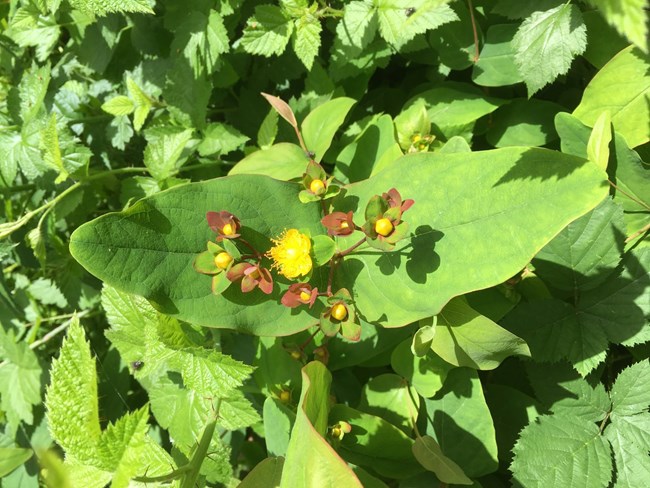
NPS / Steven Cognac
Malfurada
(Hypericum grandifolium)
During the Japanese knotweed surveys, ISED incidentally discovered a new patch of malfurada growing on the bank of Lagunitas Creek near Tocaloma. This marks the second population of malfurada reported in Lagunitas Creek, the first is upstream at the confluence of San Geronimo Creek.
Malfurada is an evergreen shrub with ovate, sessile leaves, native to the Canary Islands and Maidera. The inflorescences are cymes of large, bright yellow, five-petaled flowers. The first report of this species in California was from Marin County in 2010, and it has been found at eight locations in the county since then. Upon its discovery in California, malfurada was Q-listed by CDFA (inadequate information, but suspected to be economically or environmentally detrimental). Cal-IPC has placed malfurada on its watchlist of species that may become more widespread and invasive. Malfurada is listed as an environmental weed in South Australia and Victoria, and has been recorded as naturalized in Chile. It spreads via rhizomes and seeds, and its seeds are buoyant and can be carried by water.
The closely related Canary Island St. John’s wort (Hypericum canariense), is distinguishable by its lanceolate leaves and ovoid fruits. This plant is more widely distributed in California, occurring along the coastline from Tijuana to Oregon. It is invasive in coastal sage scrub and grasslands where it can form dense stands that crowd out native species. A single plant can produce several thousand seeds from June to September, and plants can spread or re-sprout by rhizomes. Canary Island St. John’s wort was introduced as an ornamental plant and is also invasive in Hawaii and Australia. Cal-IPC classifies the potential impact of H. canariense on California’s native ecosystems as MODERATE-Alert and CDFA ranks it as a List B noxious weed.
Resources:
Malfurada global distribution (GBIF)
Cal-IPC Plant Risk Assessment
Global Compendium of Weeds: Hypericum grandifolium
Malfurada CalFlora Interactive Distribution Map
Canary Island St Johnswort CalFlora Interactive Distribution Map
Canary Island St Johnswort Cal-IPC Plant Assessment Form
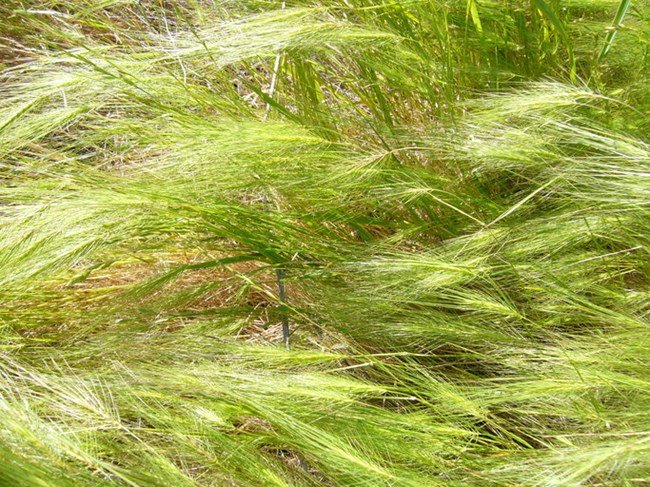
© Zoya Akulova / 2010 / CalPhotos / CC BY-NC 3.0
Medusahead
(Elymus caput-medusae)
In early May ISED detected a new patch of medusahead grass druing surveys at Pinnacles, following a reported location along highway 25. The medusahead was growing in a linear strip along the shoulder. This is the second occurrence of medusahead to be found in the park, the first was discovered and removed in 2016. This year’s new patch was immediately removed by park staff.
Medusahead is a barley-like annual grass with long-awns that is native to Western Europe. It was introduced to the United States in 1884 and was first found in Marin County in 1959 in Chileno Valley. Medusahead is considered to be one of the most impactful invasive annual grass species in rangelands of California and the western United States. It spreads rapidly and can infest disturbed or undisturbed habitats. Once established, it is difficult and costly to control without causing further impacts to grasslands. The long awns and high silica content of medusahead result in very poor forage value for livestock and wildlife. Dense infestations build up a thick layer of thatch, altering nutrient cycling, preventing establishment of native species and increasing wildfire hazard. Cal-IPC classifies the potential impact of medusahead on California’s native ecosystems as HIGH.
Landowners, land management agencies and members of the public are encouraged to keep an eye out for new infestations. Medusahead is an annual grass with long, twisting awns of two lengths, longer at the top of the infloresence and shorter at the base. The inflorescence axis of medusahead does not break apart in age, which distinguishes it from foxtail grasses (Hordeum spp.), and squirreltail (Elymus multisetus) which both have inflorescences that break apart.
Resources:
Medusahead Management Guide
CDFA Encycloweedia
Cal-IPC Plant Profile
Duncan, C.A., et al. (2004). Assessing the economic, environmental, and societal losses from invasive plants on rangeland and wildlands. Weed Technology 18:1411-1416
Spring 2018 Survey Results
Click on a point in the map below to view additional details about a specific record. This month's ISED records may also be viewed in an interactive map at the Calflora Observation Hotline. Navigate to the Help Site for assistance using the Observation Hotline.
